ARTICLES
Makie
In the Makie technique, pictures and patterns are brush-painted onto the lacquerware surface using lacquer. Next, metal powder, such as gold and silver, is sprinkled onto it to settle. Lacquer is then coated over the patterns and polished. There are three basic Makie techniques, including the above technique called Hira-Makie. The other two are Tokidashi-Makie, where you re-coat lacquer over the whole surface of the lacquerware that has been sprinkled with metal powder and then polished, and Taka-Makie, where patterns are elevated to give it three-dimensionality. Also, Makie is a Kashoku (decoration) method that allows you to make many kinds of different expressions by combing techniques such as Raden (placing and embedding green turban shells) and Hyomon (attaching thin plates of gold and silver).
Process Overview

1 Okime
First, draw a sketch of patterns on an Okime Paper (*thin paper, like Mino-Washi paper). Turn the paper over and use a paintbrush to trace sketch lines that can be seen through. During this process, use Indian red-colored lacquer as the paint. Next, press the brush-drawn surface on the lacquerware, smear it across with a spatula to copy the sketch onto the lacquerware, and then sprinkle titanium onto it.
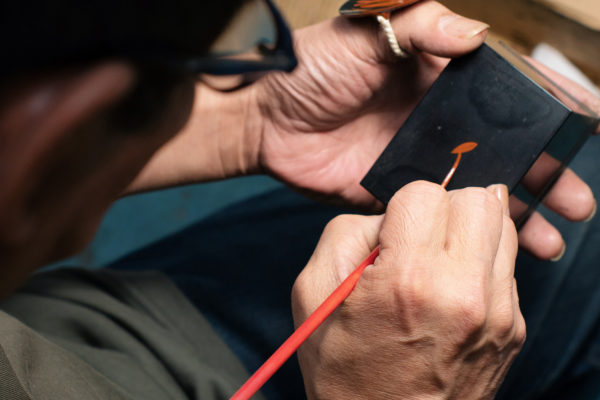
2 Draw lines/undercoating
Follow the copied sketch lines to draw the contour of patterns (draw lines) using painting lacquer (*lacquer mixed with Indian red, adjusted using oil) and paint inside the contour using a paintbrush for undercoating (undercoating).

3 Funmaki
When the lacquer is half dry, sprinkle the gold powder inside a powder tube around the patterns. Adjust the amount of gold powder by lightly tapping the powder tube with your middle finger. Next, use the brush tip of a special stick to sweep the sprinkled gold powder from the outside of the patterns to the inside, and let the gold powder settle on top of the lacquer.
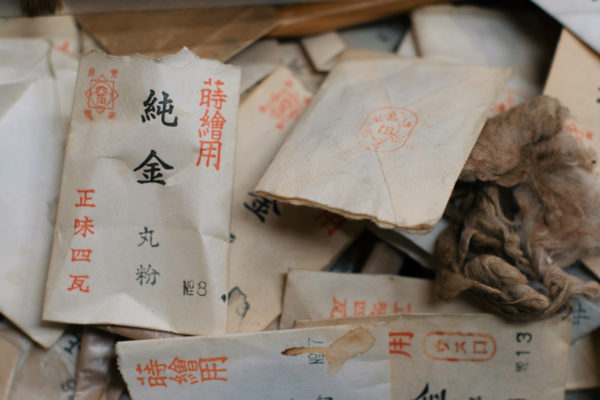
4 Suriurushi
After it is dry, wipe off any excess gold powder. The gold powder on the pattern surface needs to settle in, so put oil-thinned raw lacquer on cotton and lightly rub it in. Next, use Washi paper to wipe off excess lacquer, then dry it for about half a day in a Nushiburo (drying chamber).
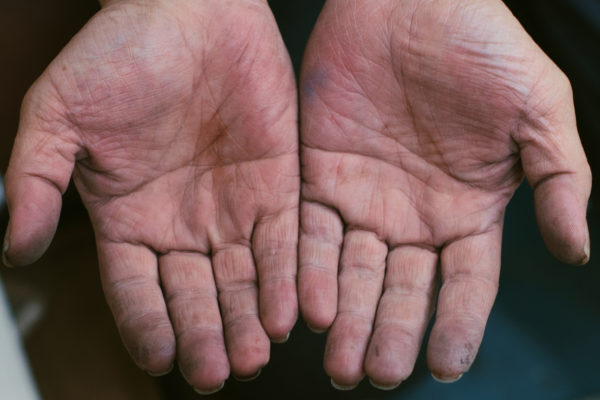
5 Polishing
After drying, put a small amount of oil on absorbent cotton and polish the surface that has been Suriurushi. Then, put deer horn powder or titanium on the balls of your fingers and polish the gold surface.
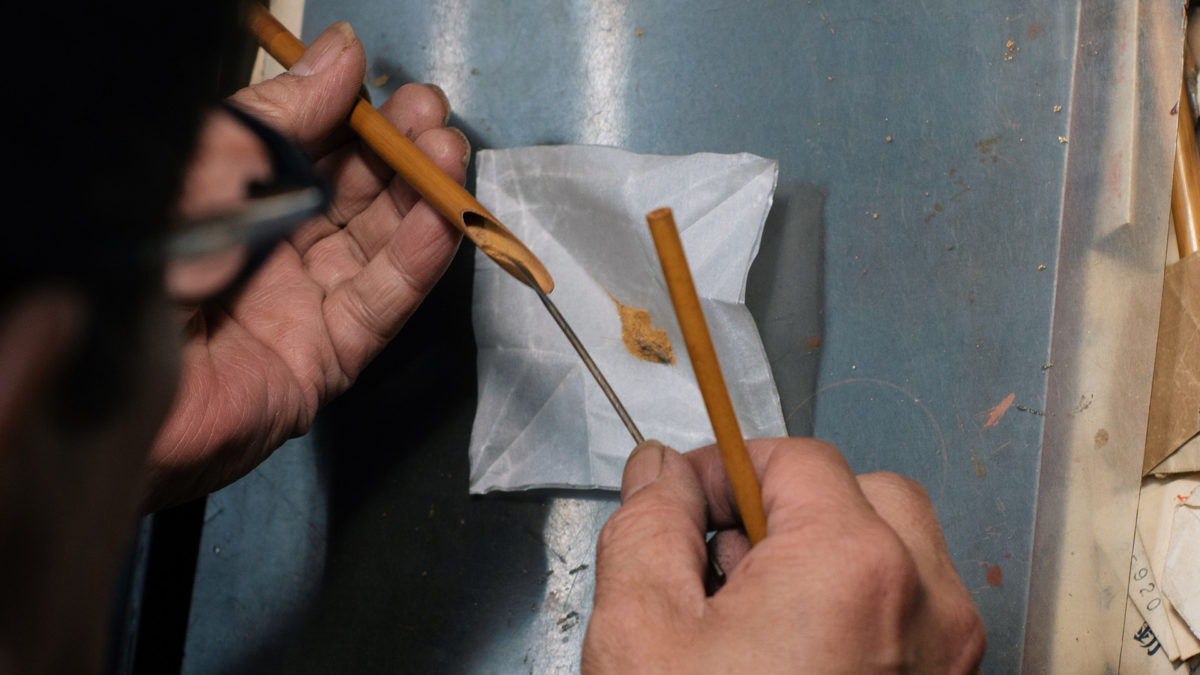
[Tools]
Makie brush, powder tube, Tsumeban, spatula, compass, etc.
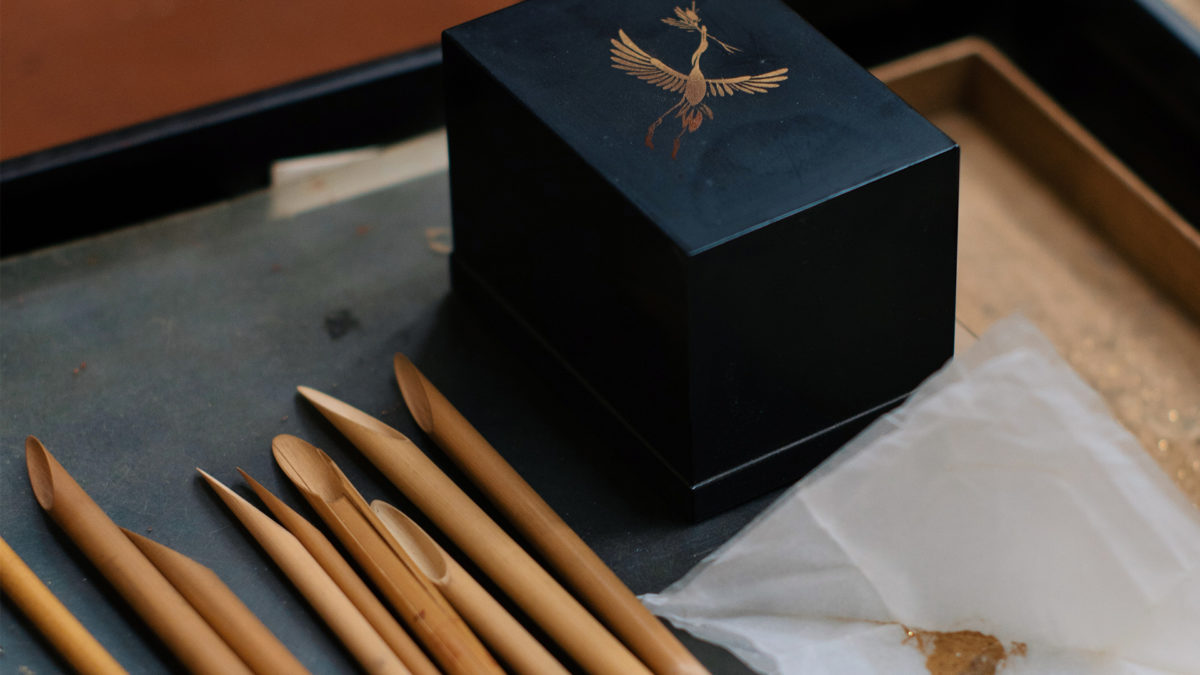
[Features and Use of Techniques]
While there are various theories regarding the origin of Makie, the technique is said to have developed uniquely in Japan. The origin of Makie goes back to the Nara Period, when it was developed as a decorative technique for katana sword sheaths. As time passed, Makie’s technology level became more advanced, and more types of expressions were produced. That is why it is a famous technique among numerous Japanese lacquer arts.
Makie may appear dazzling and gorgeous, but making it is a highly intricate process. Tremendous concentration and great skills are needed to repeatedly sprinkle metal powder, master brush usage, and coat lacquer.
“I use many tools, but the most important tool is the Makie brush. When I draw any picture (pattern), I change the thickness of lines depending on the section. In other words, I press the brush differently to make various line thicknesses, making the picture feel more three-dimensional. Furthermore, I use different brushes depending on the section to make numerous expressions. There are many kinds of brushes. I mainly use mouse and cat hair brushes as all of these brushes use very fine hair. For example, there is a brush that uses cat hair called Tamage. It absorbs lacquer well, and the hair tip is well balanced, so I often use it when I draw a long line. On the other hand, I might use a brush with a hard hair tip for Taka-Makie. As such, there are countless numbers of brushes you would use as you use different brushes depending on the type of Makie.”
As the Makie-shi, Kazuhiko Nakajima said the above, we could see a countless number of brushes beside his work desk as he claimed. Besides brushes, there were also many materials and tools, such as green turban shells used for Raden. We even found a swan egg awaiting Makie and a dog tooth used for polishing trees. I forgot to ask what the sea beam teeth and the sperm whale teeth were for.
“While it’s my job to process what customers ask me to make, I am the kind of person who wants to do everything from designing and finishing all by myself. That’s why I started to naturally have many materials and tools used in Makie, and also items used for other techniques. When I’m requested to make something, I can often propose a rare technique, which incorporating it can add my unique touch to the final product. Customers are happy about it too, which is a good thing.”
Kazuhiko has expertise in many techniques in addition to Makie, and one of the techniques he is skilled at is the dry lacquer technique. Dry lacquer is a technique of creating layers of hemp cloth using lacquer on a mold or creating three-dimensional objects by mixing polishing powder and wood powder to lacquer.
“Dry lacquer features lightness, durability, and easy modulation. It’s the same way you build Buddha statues like the Ashurazo at Kofukuji Temple. Even large objects can be created by making section by section, then sewing the fabric together. I haven’t tried this yet, but it may be interesting to make a canoe or something like that. Dry lacquer objects can float.”
Currently, Kazuhiko is fascinated by Kinkarakawa (leather with gold patterns), which is said to have originated in 15 Century Italy. He plans to make one from scratch.
“First, I plan to make one using cowhide tanned using tannin, but it will be a trial and error process. I’m not simply trying to paste gold leaf on leather. I want to create a polished Kinkarakawa with a Taka-Makie-like picture drawn on leather using lacquer, polished with a layer of gold leaf. I’ve obtained a few actual samples. Taking the extra step completely changes the finished product. I want to be thorough with this process.”
With regards to Makie, Kazuhiko said, “Before, I did Makie on fountain pens and Dunhill cigarette cases and lighters.” However, Kazuhiko wanted to do Makie in more areas, so he said, “I want to ask people in the fashion industry about interesting items to do Makie on. They might have an idea that us craftsmen can never think of.”
An important factor in coming up with applications for a technique is to step across different industries so that you can look at the technique from different perspectives, discovering new appeals and possibilities. For this purpose, people from many different industries need to interact and exchange opinions.
